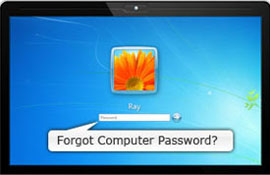“I forgot my Windows 7 password and now I cannot log into my computer. What should I do?”
This problem occurs to every computer users. To fix it, you need a Windows 7 password reset USB disk, which can help you reset the forgotten password. In this article, you will learn 2 simple ways to create a Windows 7 password reset USB disk.
Method 1: Use Windows built-in tool
Regarding the problem concerning a forgotten or lost login password, Windows 7 incorporates features to allow you create a password reset USB disk before the password is forgotten. It’s a precautionary measure. Unfortunately, many PC users ignore it. If you belong to one of those users, please skip and go to Method 2. If not, follow the directions listed below to create a Windows 7 password reset USB to in case of a forgotten password.
1. Log on to the Windows 7 computer through the user account that you want to create the password reset USB for.
2. Go to User Accounts window by clicking Start button – Control Panel – Family Safety and User Accounts – User Accounts.
3. Click on “Create a password reset disk” link on the left pane.
4. Follow the coming Forgotten Windows Password Wizard and create a password reset disk with a USB flash drive.
Note: This method is only available before you forgot the Windows 7 password.
Method 2: Use Windows password reset tool
Windows Password Breaker is easy yet powerful Windows 7 password reset tool. It can help you burn a Windows password reset USB disk to reset your forgotten login password for Windows 7/Vista/XP/2008/2003/2000. 100% secure. No any data loss or damage.
1. Download and install Windows Password Breaker Professional in any computer.
2. Launch the program and insert a USB flash drive in computer.
3. Burn a Windows 7 password reset USB disk by clicking on “Remove Windows Local password” – selecting USB flash drive – clicking Burn button.
You can create a Windows 7 password reset USB by following the steps above whenever you want to. But usually users turn to it when they forgot Windows 7 password and cannot access computer any longer. What’s more, this disk is a bootable one.
How to use the Windows 7 password reset USB disk?
The Windows 7 password reset USB disk either by method 1 or method 2 can efficiently reset your forgotten Windows 7 password. But it differs in using the disk to reset your lost Windows 7 password.
For the Windows 7 password reset USB created by the former method, just start/restart your Windows 7 machine. On the login screen, click the target user account and try to log into it with a wrong password. Then you will see a “Reset password” link under the password box. Click it and bring up the Password Reset wizard. Next all you should do is to follow the wizard and reset your forgotten Windows password to a new one.
To use the Windows 7 password reset USB created through Windows Password Breaker, insert the disk in the computer you want to reset password of. Next start the computer from the disk and you’ll be able to reset your lost Windows 7 password to blank under DOS command prompt. It is very easy and takes you about one minute.
Windows 7 password reset, Windows 7 password reset USB
